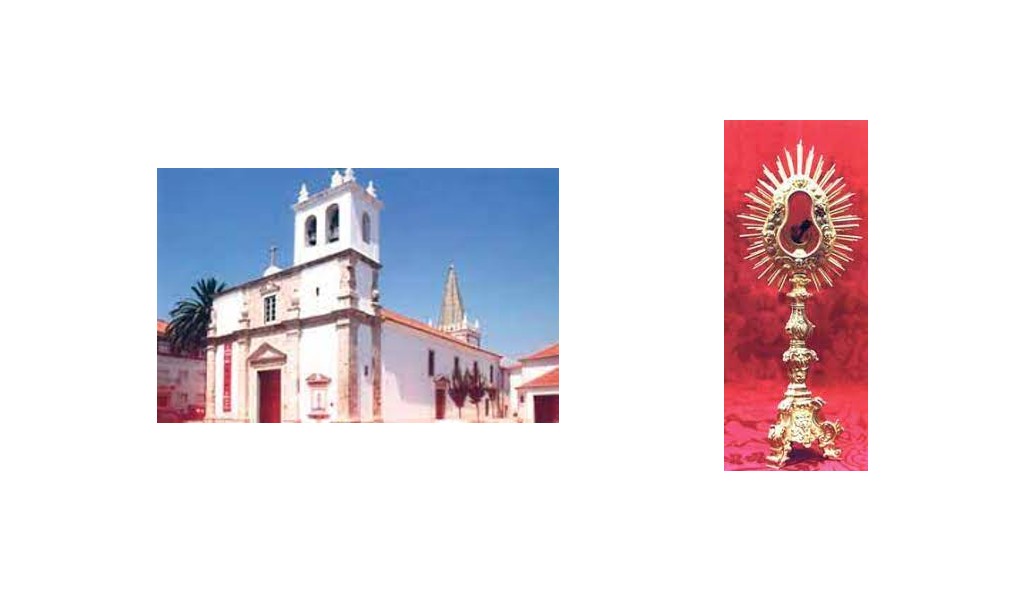Santarém is a city in Portugal only half an hour from Fatima, a famous site where Mary appeared multiple times to three shepherd children. The eucharistic miracle that occurred in Santarém is considered by many to be the second most famous, after the one that happened in Lanciano, Italy. The Church has approved this miracle, and three different popes have granted plenary indulgences to those who visit. The remarkable story of what happened reads like a fairy tale, but King Alfonso IV of Portugal commissioned a carefully documented account in 1346. In 1997, scientists carefully analyzed the evidence, and the miracle remains valid today.
A Desperate Act, Then Transformation
On February 16, 1266, a woman of Santarém, distraught because her husband had been repeatedly unfaithful to her, sought the assistance of a local sorceress in winning him back. The sorceress said she could help but told the woman she needed to bring her a consecrated host as payment. The desperate woman reluctantly agreed, so the next time she received holy Communion at the local Church of St. Stephen, she slipped the host out of her mouth, wrapped it in her veil and set off for the sorceress. But after only a few steps, she felt the veil in her hand becoming wet. Looking down, she saw that it was soaked with blood, to the point that it was dripping. Passersby stopped to ask if she needed help, thinking her hand was seriously wounded.
The shocked woman decided not to proceed to the sorceress but instead raced home, where she hid the bloody veil containing the host in the bottom of a wooden trunk in her bedroom. That night, she and her husband were awakened by a light coming from the trunk. The light was so bright it filled the room as if it were daytime. The woman quickly confessed to her husband what she had done, and both knelt in adoration and repentance till dawn.
Word Spreads, Another Miracle Follows
The couple informed the priest of the Church of St. Stephen in the morning, and word spread quickly among the townspeople. The priest went to their home, retrieved the bleeding host, and carried it to the church in solemn procession, accompanied by many religious and lay people. The host continued to bleed for three consecutive days. The priest then put the host in a reliquary made from melted beeswax candles and placed it in the tabernacle.
In 1340, a second miracle occurred. A priest unlocked the tabernacle for the faithful to venerate the miracle and saw that the wax reliquary had burst into tiny pieces. In its place, he found a crystal vessel containing the host and the blood. The priest later placed the host in a gold and silver pear-shaped monstrance, where the miracle can still be seen and venerated today. In 1997, scientific tests confirmed that the contents in the vessel were human flesh and blood, with the same rare AB+ blood type as the Shroud of Turin and other eucharistic miracles, such as Lanciano.
His Presence and His Love Endure, Changes Hearts
This is an amazing miracle that has been preserved for more than 750 years. Many saints and royalty throughout history have venerated the miraculous host of Santarém, such as Queen St. Elizabeth of Portugal, who visited it in 1295 and 1322. In the mid-16th century, St. Francis Xavier also came to Santarém on a pilgrimage before embarking on his great missionary journey to India. Annually, on the second Sunday of April, the eucharistic miracle is carried in a procession that begins at the house where the couple lived and ends at the church, whose name was changed from St. Stephen to the Church of the Holy Miracle.
What can we take from this miracle, aside from the fact that it strengthens our faith once again as we celebrate this time of Eucharistic Revival?
Perhaps this: Christ took what began as a sacrilegious act—the intended delivery of His eucharistic body to a sorceress for desecration—and turned it into a testimony of His Real Presence for generations to witness. Not only that, He also took the desperate act of a desperate woman and transformed it into a way to reach and convert her heart as well as that of her wayward husband. It is as if He was betrayed and delivered to death once again, but by giving us His sacred body and blood, He brought salvation yet again. What a merciful, loving Lord we have!
Story by Chris Ruff, Director of the Office for Ministries and Social Concerns
Published in the March/April 2024 issue of Catholic Life Magazine

